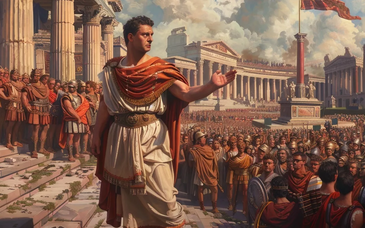The patricians found it at least necessary to make occasional concessions - often indeed such that their expected effect could be practically evaded. As early as 445 BC they were obliged to legalize marriage between patrician and plebeian. But they fought to the last against admitting plebeians to the magistracies. In fact, it was only when the old warrior Camillus, the hero of aristocratic conservatism, realized that it was no use to keep up the struggle against the inevitable, that the measure known as the Licinian Rogations, combining the agrarian and constitutional demands of the plebeians, was passed in 367 BC.
The agrarian part of the Licinian Rogations was too easily evaded to be effective in the long run. But the enactment that thenceforth one of the consuls must be a plebeian was the death-blow to the privileges of the old aristocracy.
However, by that time the office of consul was largely a formal position. Varro describes the consul being called so, "as he consults the senate".
However, the Roman constitution allowed that in times of crisis and particularly war, that one 'dictator' be appointed who could exercise total power for six months. It was an ancient office, having originated from the rule that one military commander being appointed over the armies of several Latin cities. This rank was referred to as 'master-of-infantry'. In republican days the title survived in form of the dictator's second in command who was 'master-of-cavalry'.
It was in the same year, 367 BC, that the great tyrant Dionysius of Syracuse died, leaving to his son the empire which at the moment seemed destined to dominate Italy, a more mighty power than the expanding republic on the Tiber.
But the future lay with the republic.
At the moment when the consulships in 367 ceased to be the monopoly of the old aristocracy Rome was more powerful than any other single state in Italy. Notwithstanding this, the area of her supremacy was still limited to Latium and a portion of Etruria, and even within that area her domination was liable to be challenged.
And now she was to find herself faced by a new and formidable foe in a new guise, the Samnite confederacy.
The leading feature in the advance of Rome is to be found in the series of Samnite wars beginning in 363 BC and ending in 290 BC.
But before the struggle with the Samnites opened, the ascendancy which Rome had been able to establish after the Gallic irruption was seriously threatened. It was perhaps only because the neighbours who feared her feared still more the Gallic menace from which they had already suffered so severely, that Rome was able to do something more than hold her own. There were, moreover, Latin cities which even allied with the Gauls against her, thereby forcing the rest of the Latins, however reluctantly, to throw themselves in effect under the protection of Rome, in spite of the subordination to her involved. The Latin League was renewed on terms more definitely emphasizing the superior status of Rome (358 BC), and the second Gallic tide was rolled back in 354 BC.
Etruscan cities seized the opportunity to attack Rome in the hour of her embarrassment. She suffered some defeats, but by 351 BC the Etruscans were forced to accept a peace for forty years.
In that year and the next the Gauls renewed hostilities for the third time, only to be decisively beaten by the son of the great Camillus who had beaten them off forty years before.
The Latins were held well in hand, and Etruria was bound to peace for many years to come. At this stage, then, Carthage recognized Rome as the coming great power, and made with her the very important treaty of 348 BC - in the view of some authorities, the first between the two states, while others regard it as a simple renewal of a treaty supposedly made in 509 BC, he first year of the republic.



